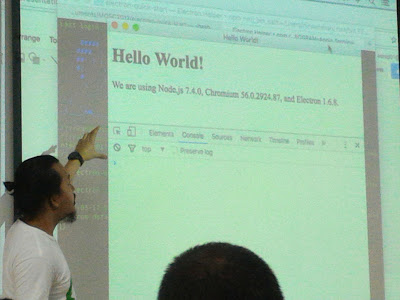Malaysia Open Source Conference (MOSC) 2017
A three days Malaysia Open Source Conference (MOSC) ended last week. MOSC is an open source conference which is held annually and this year it reaches its 10 years anniversary. I managed to attend the conference with a selective focus on system administration related presentations, computer security and web application development.
The First Day
The first day’s talks were occupied with keynotes from the conference sponsors and major IT brands. After the opening speech and a lightning talk from the community, Mr Julian Gordon delivered his speech which regards to the Hyperledger project, a blockchain technology based ledger. Later Mr Sanjay delivered his speech on the open source implementation in the financial sector in Malaysia. Before lunch break we then listened to Mr Jay Swaminathan from Microsoft whom presented his talks on Azure based service for blockchain technology.
For the afternoon part of the first day I then attended a talk by Mr Shak Hassan on the Electron based application development. You can read his slides here. I personally used Electron based application for Zulip so basically as a non web developer I already have a mental picture what Electron is prior to the …
conference
Age comparison in Bash for files and processes
You want your script to run a command only if elapsed-time for a given process is greater than X?
Well, bash does not inherently understand a time comparison like:
if [ 01:23:45 -gt 00:05:00 ]; then
foo
fiHowever, bash can compare timestamps of files using -ot and -nt for “older than” and “newer than”, respectively. If the launch of our process includes creation of a PID file, then we are in luck! At the beginning of our loop, we can create a file with a specific age and use that for quick and simple comparison.
For example, if we only want to take action when the process we care about was launched longer than 24 hours ago, try:
touch -t $(date --date=yesterday +%Y%m%d%H%M.%S) $STAMPFILEThen, within your script loop, compare the PID file with the $STAMPFILE, like this:
if [ $PIDFILE -ot $STAMPFILE ]; then
foo
fiAnd of course if you want to be sure you’re working with the PID file of a process which is actually responding, you can try to send it signal 0 to check:
if kill -0 `cat $PIDFILE`; then
foo
fishell
End Point Liquid Galaxy at GEOINT Symposium
End Point Liquid Galaxy will be coming to San Antonio to participate in GEOINT 2017 Symposium. We are excited to demonstrate our geospatial capabilities on an immersive and panoramic 7 screen Liquid Galaxy system. We will be exhibiting at booth #1012 from June 4-7.
On the Liquid Galaxy, complex data sets can be explored and analyzed in a 3D immersive fly-through environment. Presentations can highlight specific data layers combined with video, 3D models, and browsers for maximum communications efficiency. The end result is a rich, highly immersive, and engaging way to experience your data.
Liquid Galaxy’s extensive capabilities include ArcGIS, Cesium, Google Maps, Google Earth, LIDAR point clouds, realtime data integration, 360 panoramic video, and more. The system always draws huge crowds at conferences; people line up to try out the system for themselves.
End Point has deployed Liquid Galaxy systems around the world. This includes many high profile clients, such as Google, NOAA, CBRE, National Air & Space Museum, Hyundai, and Barclays. Our clients utilize our content management system to create immersive and interactive presentations that tell engaging stories to their …
video conference visualization gis visionport event
Postal code pain and fun
 We do a lot of ecommerce development at End Point. You know the usual flow as a customer: Select products, add to the shopping cart, then check out. Checkout asks questions about the buyer, payment, and delivery, at least. Some online sales are for “soft goods”, downloadable items that don’t require a delivery address. Much of online sales are still for physical goods to be delivered to an address. For that, a postal code or zip code is usually required.
We do a lot of ecommerce development at End Point. You know the usual flow as a customer: Select products, add to the shopping cart, then check out. Checkout asks questions about the buyer, payment, and delivery, at least. Some online sales are for “soft goods”, downloadable items that don’t require a delivery address. Much of online sales are still for physical goods to be delivered to an address. For that, a postal code or zip code is usually required.
No postal code?
I say usually because there are some countries that do not use postal codes at all. An ecommerce site that expects to ship products to buyers in one of those countries needs to allow for an empty postal code at checkout time. Otherwise, customers may leave thinking they aren’t welcome there. The more creative among them will make up something to put in there, such as “00000” or “99999” or “NONE”.
Someone has helpfully assembled and maintains a machine-readable (in Ruby, easily convertible to JSON or other formats) list of the countries that don’t require a postal code. You may be surprised to see on the list such countries as Hong Kong, Ireland, Panama, Saudi Arabia, and South Africa. Some countries on the list …
ecommerce perl shipping
Designing a Computer Science Program for Free (or Cheap)
This blog post is for people like me who are interested in improving their knowledge about computers, software and technology in general but are inundated with an abundance of resources and no clear path to follow. Many of the courses online tend to not have any real structure. While it’s great that this knowledge is available to anyone with access to the internet, it often feels overwhelming and confusing. I always enjoy a little more structure to study, much like in a traditional college setting. So, to that end I began to look at MIT’s OpenCourseWare and compare it to their actual curriculum.
I’d like to begin by acknowledging that some time ago Scott Young completed the MIT Challenge where he “attempted to learn MIT’s 4-year computer science curriculum without taking classes”. My friend Najmi here at End Point also shared a great website with me to “Teach Yourself Computer Science”. So, this is not the first post to try to make sense of all the free resources available to you, it’s just one which tries to help organize a coherent plan of study.
Methodology
I wanted to mimic MIT’s real CS curriculum. I also wanted to limit my studies to Computer Science only, while stripping …
training education
The New Earth
As many of you may have seen, earlier this week Google released a major upgrade to the Google Earth app. Overall, it’s much improved, sharper, and a deeper experience for viewers. We will be upgrading/incorporating our managed fleet of Liquid Galaxies over the next two months after we’ve had a chance to fully test its functionality and polish the integration points, but here are some observations for how we see this updated app impacting the overall Liquid Galaxy experience.
Hooray! The new Earth is here! The New Earth is here! Certainly, this is exciting for us. The Google Earth app plays a key central role in the Liquid Galaxy viewing experience, so a major upgrade like this is a most welcome development. So far, the reception has been positive. We anticipate it will continue to get even better as people really sink their hands into the capabilities and mashup opportunities this browser-based Earth presents.
We tested some pre-release versions of this application, and successfully integrated them with the Liquid Galaxy and are very happy with how we are able to view-synchronize unique instances of the new Google Earth across displays with appropriate geometrically configured …
browsers google-earth visionport
Job opening: Web developer
This position has been filled. See our active job listings here.
We are looking for another talented software developer to consult with our clients and develop web applications for them in Ruby on Rails, Django, AngularJS, Java, .NET, Node.js, and other technologies. If you like to solve business problems and can take responsibility for getting a job done well without intensive oversight, please read on!
End Point is a 20-year-old web consulting company based in New York City, with 45 full-time employees working mostly remotely from home offices. We are experts in web development, databases, and DevOps, collaborating using SSH, Screen/tmux, chat, Hangouts, Skype, and good old phones.
We serve over 200 clients ranging from small family businesses to large corporations. We use open source frameworks in a variety of languages including JavaScript, Ruby, Java, Scala, Kotlin, C#, Python, Perl, and PHP, tracked by Git, running mostly on Linux and sometimes on Windows.
What is in it for you?
- Flexible full-time work hours
- Paid holidays and vacation
- For U.S. employees: health insurance subsidy and 401(k) retirement savings plan
- Annual bonus opportunity
- Ability to move without being tied to your job location
What you will be doing:
- Work from your home …
jobs-closed
The mystery of the disappearing SSH key
SSH (Secure Shell) is one of the programs I use every single day at work, primarily to connect to our client’s servers. Usually it is a rock-solid program that simply works as expected, but recently I discovered it behaving quite strangely - a server I had visited many times before was now refusing my attempts to login. The underlying problem turned out to be a misguided decision by the developers of OpenSSH to deprecate DSA keys. How I discovered this problem is described below (as well as two solutions).
The use of the ssh program is not simply limited to logging in and connecting to remote servers. It also supports many powerful features, one of the most important being the ability to chain multiple connections with the ProxyCommand option. By using this, you can “login” to servers that you cannot reach directly, by linking together two or more servers behind the scenes.
As as example, let’s consider a client named “Acme Anvils” that strictly controls access to its production servers. They make all SSH traffic come in through a single server, named dmz.acme-anvils.com, and only on port 2222. They also only allow certain public IPs to connect to this server, …
security ssh










